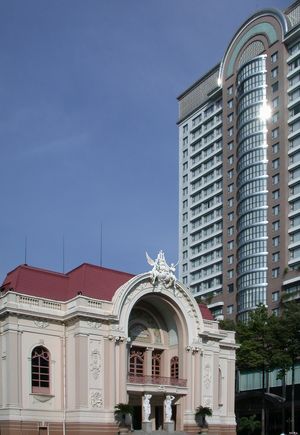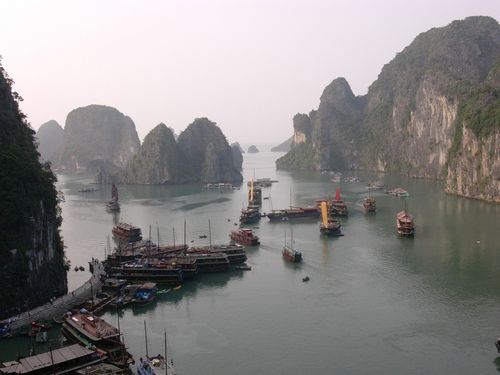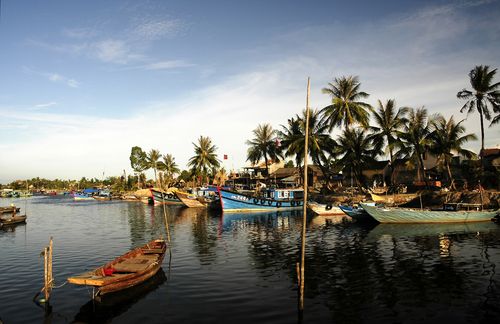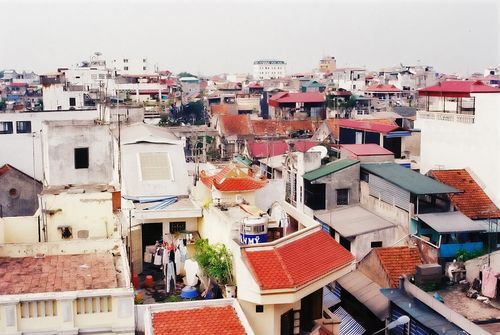|
|

Opera House at Ho Chi Minh City |
|
Vietnam is a Southeast Asian country that hasn’t let the aggressions of urbanisation throttle the flow of traditional lifestyle. It is a land of captivating natural beauty and tranquil village life where the farmers in cone-shaped cane hat are a regular feature. Vietnam’s islands and beaches are among the finest in the entire Asian continent and its cuisine is very possibly the most delicious you will ever find. This amazing tropical destination is surrounded by China on the north, by Laos and Cambodia on the west and by the Gulf of Tonkin and the South China Sea on the east and south. Hanoi, in the northern Vietnam is the capital city of the country and Ho Chi Minh City or Saigon, in the south, is Vietnam's largest city.
Vietnam survived years of French colonial rule and the devastation of the infamous Vietnam War. Today, this gracious and graceful country is an outstanding travel destination. The pleasant experience in the country is further enhanced by the warmth and hospitality of the native Vietnamese who account for more than 85% of the population. The remaining twenty percent of the populace comprises more than fifty separate ethnic groups and majority of these minorities are members of the hill tribes or Montagnards who stay in the northern hills. Officially, Vietnam doesn’t adhere to any particular religion but in reality, a mix of Buddhism, Confucianism, and traditional local beliefs and Roman Catholicism are the most widely practiced religions.
 Halong Bay
Halong Bay
|
Geography
Vietnam is S-shaped country that stretches along the length of the Indo-Chinese Peninsula. Spread over an area of 331,688 square kilometres, the country has fairly distinct topographical division of its terrain. The north is known for the dense populated Red River Delta. The plain alluvial land sprawls over an area of nearly 3,000 sq km and is the agricultural base of Vietnam. The waters from the tributaries of Red River, which are the Song Lo and the Song Da, further enhance the irrigation of the country. This river basin is also home to some dense forests, the enchanting Halong Bay and the capital city of Hanoi. The mountains and highlands of Vietnam appear on the northwest of the country and they rise to the highest peak of Phan Xi Păng at 3,142 metres. The central potion of Vietnam is characterized by high temperate plateaus rich in volcanic soil and by spectacular beaches, dunes, and lagoons. The coastal lowlands along the eastern borders of the country are also home to a major part of the Vietnamese population. The fertile delta of the Mekong River in the south of Vietnam is one of the largest in the world with an area covering 40,000 sq km. The fertile valley is continuously expanding following the heavy sedimentation from the Mekong River and its tributaries. Here flourishes the modern life in Ho Chi Minh City, formerly Saigon.
 Hoi An Harbour
Hoi An Harbour
|
Climate
Vietnam experiences separate climatic conditions due to its elongated shape that entails difference in latitude. The north of Vietnam has a temperate climate with distinct winter and summer season. The winters lasting from November through April, are mainly dry with summers, lasting from May to October, that are hot and humid. A travel down the central and southern parts of the country brings along very hot, dry weather which are balanced out by heavy rainfall.
History
Vietnam was officially united on April 30, 1975, when communist forces of the North overtook the more westernised South Vietnam. Since then, the country has done a remarkable job of healing its wounds. Historians believe that Vietnam was inhabited thousands of years ago by aboriginal Vietnamese tribes until China conquered the area and ruled for over a thousand years. Vietnam, originally known as Nam Viet, freed out of the Chinese rule in the tenth century. The following hundred years of independence was interrupted by French colonisation in 19th century. The Japanese arrived to Vietnam during the Second World War.
The first instance of division and infighting of Vietnam became evident in 1945 when Ho Chi Minh, the communist leader, declared a democratic republic in Hanoi. The Geneva Accords Geneva divided Vietnam into North Vietnam and South Vietnam. The American involvement came into this Vietnamese entanglement when the Communist northern side tried to overpower the southern side. What started as a political manoeuvring ended up as one of the worst diplomatic moves for United States of America in the form of Vietnam War. Vietnam witnessed bloodbath for almost a decade, starting from 1964. After many Vietnamese and Americans lost their lives, a ceasefire was negotiated and US troops withdrew in 1973. Finally, in 1975, Vietnam was unified under the North Vietnamese troops and the Socialist Republic of Vietnam was established.
 Rooftops in Hanoi
Rooftops in Hanoi
|
Economy
Vietnam took a dramatic turnaround during the last decade of twentieth century. It wiped out the economic debacle miraculously and projected one of the most extraordinary financial success stories in the world. Vietnam got rid off the rigidity of a centrally planned economy and drove towards a more open economic module. Apart from the problems of unemployment and unequal distribution, the country enjoys a healthy growth rate of nearly 8.5 % per annum.
 Worker in Paddy Field
Worker in Paddy Field
|
Politics
The political set up of Vietnam is based on the 1992 constitution and the Communist Party of Vietnam is the dominant player in the legislative and executive arena. The president is regarded as the chief of state and is elected by members of the unicameral Vietnamese national Assembly or Quoc-Hoi. The 498 members of the assembly are elected by popular vote to serve five-year term. The Prime Minister, four deputy prime minister and 31 cabinet ministers are all members of the National assembly and are appointed by the president. The Supreme People's Court heads the judiciary of the Vietnam.
|
|

